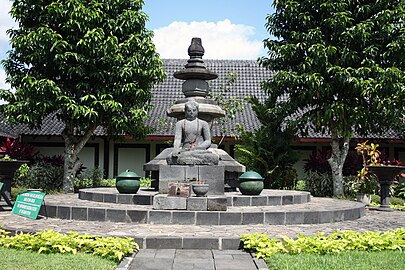
Borobudur, also transcribed Barabudur is a 9th-century Mahayana Buddhist temple in Magelang Regency, not far from the city of Magelang and the town of Muntilan, in Central Java, Indonesia.

Sanchi is a Buddhist complex, famous for its Great Stupa, on a hilltop at Sanchi Town in Raisen District of the State of Madhya Pradesh, India. It is located, about 23 kilometers from Raisen town, district headquarter and 46 kilometres (29 mi) north-east of Bhopal, capital of Madhya Pradesh.
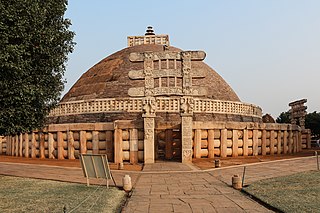
In Buddhism, a stupa is a mound-like or hemispherical structure containing relics that is used as a place of meditation.

Prambanan is a 9th-century Hindu temple compound in the Special Region of Yogyakarta, in southern Java, Indonesia, dedicated to the Trimūrti, the expression of God as the Creator (Brahma), the Preserver (Vishnu) and the Destroyer (Shiva). The temple compound is located approximately 17 kilometres (11 mi) northeast of the city of Yogyakarta on the boundary between Central Java and Yogyakarta provinces.
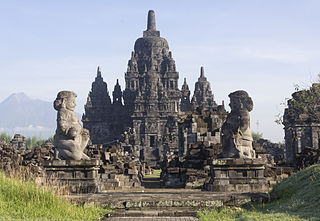
A Buddhist temple or Buddhist monastery is the place of worship for Buddhists, the followers of Buddhism. They include the structures called vihara, chaitya, stupa, wat and pagoda in different regions and languages. Temples in Buddhism represent the pure land or pure environment of a Buddha. Traditional Buddhist temples are designed to inspire inner and outer peace.
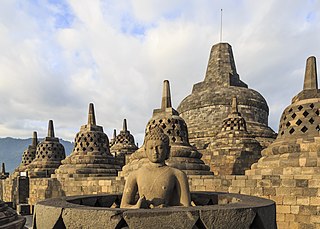
Buddhist religious architecture developed in the Indian subcontinent. Three types of structures are associated with the religious architecture of early Buddhism: monasteries (viharas), places to venerate relics (stupas), and shrines or prayer halls, which later came to be called temples in some places.

A candi is a Hindu or Buddhist temple in Indonesia, mostly built during the Zaman Hindu-Buddha or "Hindu-Buddhist period" between circa the 4th and 15th centuries.
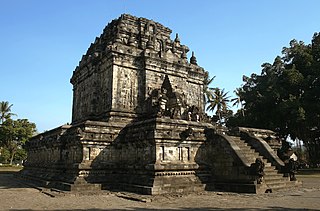
Mendut is a ninth-century Buddhist temple, located in Mendut village, Mungkid sub-district, Magelang Regency, Central Java, Indonesia. The temple is located about three kilometres east of Borobudur. Mendut, Borobudur, and Pawon, all of which are Buddhist temples, are located in one straight line. There is a mutual religious relationship between the three temples, although the exact ritual process is unknown.

Sewu is an eighth century Mahayana Buddhist temple located 800 metres north of Prambanan in Central Java, Indonesia. The word for a Hindu or Buddhist temple in Indonesian is "candi", hence the common name is "Candi Sewu". Candi Sewu is the second largest Buddhist temple complex in Indonesia; Borobudur is the largest. Sewu predates nearby "Loro Jonggrang" temple at Prambanan. Although the complex consists of 249 temples, this Javanese name translates to 'a thousand temples,' which originated from popular local folklore. Archaeologists believe the original name for the temple compound to be Manjusrigrha.

Prambanan Temple Compounds is the World Heritage designation of a group of Hindu temple compounds that lie on the border between Yogyakarta and Central Java, Indonesia. It comprises Prambanan, Lumbung, Bubrah and Sewu temple compounds, all are located within Prambanan Archaeological Park.

Kewu Plain, also known as Prambanan Plain or Opak River valley, is a fertile volcanic plain that lies between Merapi-Merbabu complex in the north, Bantul lowlands and Sewu karst limestone range in the south, Bengawan Solo river valley in the east, the Progo River in the west, and Kedu Plain on northwest. It is located within the Yogyakarta Special Region, Sleman Regency, Klaten Regency and Solo City, Indonesia.

Banyunibo is a 9th-century Buddhist temple located in Cepit hamlet, Bokoharjo village, Prambanan, Sleman Regency, Special Region of Yogyakarta, Indonesia. The temple, dating from the era of Mataram Kingdom, sits in a narrow valley surrounded by paddy fields about two kilometers southeast of the Ratu Boko archaeological park on the east side of modern Yogyakarta. Further north is the Prambanan temple, and to the south are the Gunung Sewu hills, extension of Gunung Kidul hills.

Samudra Raksa Museum is a maritime museum that was built several hundred meters north of the 8th-century Borobudur Buddhist monument, within the Borobudur archaeological complex, Magelang, Central Java, Indonesia. The museum features and interprets the ancient maritime Indian Ocean trade among between ancient Indonesia, Madagascar, and East Africa, popularly dubbed as "the cinnamon route". The centerpiece of museum is the full-scale reconstruction of the 8th-century Borobudur ship. It was used in a successful expedition from Indonesia to Madagascar and Ghana in 2003—2004. The Borobudur Ship — a 25 meter-long wooden ship modeled after wall reliefs found on the 8th century Borobudur temple in Central Java.

Sojiwan is a 9th-century Mahayana Buddhist temple located in Kebon Dalem Kidul village, Prambanan, Klaten Regency, Central Java. The temple is located nearly two kilometres southeast of Prambanan temple. This temple is among numbers of temples scattered in Prambanan Plain.

Jabung is a 14th-century Buddhist temple dated from Majapahit era, located in the Jabung Sisir village (desa), Paiton area, Probolinggo district, East Java, Indonesia. The temple is made from red brick measuring 16.20 metres. The temple was mentioned in Nagarakretagama as Bajrajinaparamitapura, being visited by king Hayam Wuruk during his royal tour across East Java in 1359 CE. The temple is mentioned in Pararaton as Sajabung, a mortuary temple of Bhre Gundal, a member of Majapahit royalties.
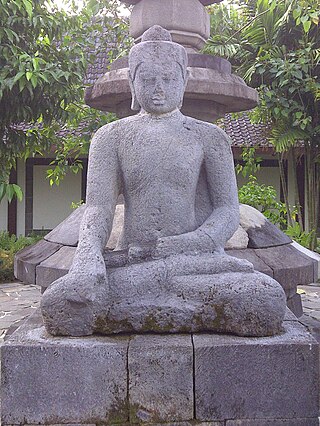
The Unfinished Buddha is a statue which is believed to have originated from the largest stupa of Borobudur. It is currently located in Karmawibhangga Museum.
Buddhavanam is a tourism project in Nagarjuna Sagar, Telangana created by the Telangana State Tourism Development Corporation. The project was sanctioned by the Government of India viz., Integrated Development of Nagarjunasagar as part of Lower Krishna valley Buddhist circuit with a view to attract large number of domestic and foreign tourists particularly from the South-East Asian countries.

The archaeology of Indonesia is the study of the archaeology of the archipelagic realm that today forms the nation of Indonesia, stretching from prehistory through almost two millennia of documented history. The ancient Indonesian archipelago was a geographical maritime bridge between the political and cultural centers of Ancient India and Imperial China, and is notable as a part of ancient Maritime Silk Road.

Sumberawan is a Buddhist stupa located in Toyomarto village, Sumberawan subdistrict, Malang Regency, East Java, Indonesia. The stupa is located in the highlands, on the southern slope of Mount Arjuno, surrounded by numerous Springs.
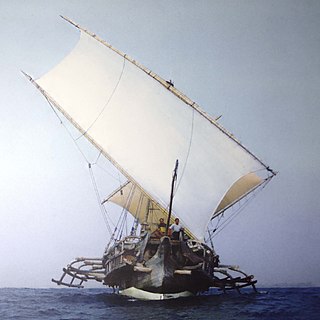
Samudra Raksa is a replica ship built in 2003 based on the relief of ships in the Borobudur temple. In the late 20th century, Philip Beale, a British sailor, became interested in depictions of the ship at Borobudur and decided to reconstruct one. Aided by government and international bodies, he organized an expedition team that constructed the ship and, from 2003 to 2004, sailed it from Indonesia to Madagascar and to Ghana, proving that long-distance trade could have occurred. The Samudra Raksa Museum was constructed at Borobudur Archeological Park to house the ship, opening in 2005, and provides other displays to interpret the ancient maritime history of Indonesians.





